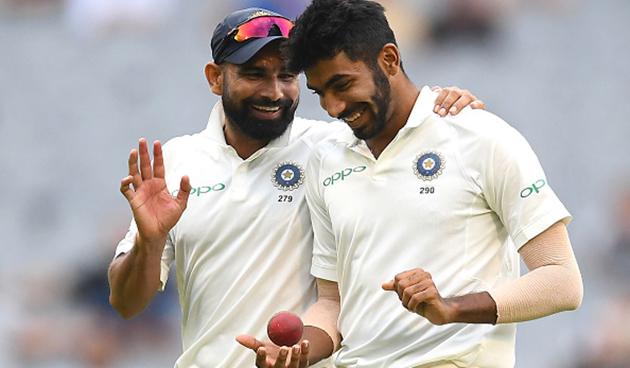Never thought I’d see an Indian fast bowler successfully executing nine yorkers out of 10: Karsan Ghavri
In an exclusive chat with Hindustan Times, Ghavri admits that India’s fast bowlers going around the world and dominating batting line-ups is a sight he never imagined he’d see.
Karsan Ghavri belongs to an era when India were yet to develop fast bowlers, banking primarily on spinners to win matches. At a time when Bhagwat Chandrasekhar, Erapalli Prasanna, Bishan Singh Bedi and S Venkataraghavan were ruling world cricket, spinning out match-winning spells for India between 1950 and 1970, Ghavri, a nippy left-arm quick, emerged as the first real fast bowler produced by India. Ghavri assisted and shared the new ball with the legendary Kapil Dev when the Haryana Hurricane was a newcomer.

So when Ghavri speaks about something, you listen, especially if it’s about India’s current fast stock. Immensely impressed by what he sees, Ghavri admits that India’s fast bowlers going around the world and dominating batting line-ups is a sight he never imagined he’d see.
“India has the best fast bowling attack in the world, which is extraordinary,” Ghavri told Hindustan Times during an exclusive conversation. “Mohammed Shami, Ishant Sharma, Jasprit Bumrah, Bhuvneshwar Kumar... you cannot go wrong with these guys. They’ve been performing extremely well. To win a Test match, you need to take 20 wickets and due to these bowlers, India have been able to do so regularly and effectively.”
Also Read | Please not against Australia, do it vs Pak, WI: Lee’s request for India opener
Ghavri is particularly impressed with Bumrah, who he feels in four years since his India debut, has transformed into the best in the world. And it’s hard to argue why. Earlier this year, Bumrah won the Polly Umrigar Award, for being at the forefront of India’s fast bowling contingent’s rise, playing a pivotal role in all three formats. Since making his Test debut in January 2018, Bumrah has played 14 Tests and already taken 68 wickets at an average of 20.33 including five five-wicket hauls. He scalped 21 wickets during the 2018-19 Border-Gavaskar trophy, a series in which India made history by beating Australia on their soil for the first time in 71 years.
In August last year, Bumrah became only the third Indian bowler to pick up a Test hat-trick and picked up 13 wickets as India steamrolled West Indies 2-0. Bumrah has recorded a five-wicket-haul in England, Australia, South Africa and West Indies becoming the first and only Asian bowler to achieve the feat. Ghavri remembers spotting a young Bumrah years ago, and believes his rise is almost second to none.
“In the beginning, when he started playing Ranji Trophy for Gujarat. No one thought he would scale the peak he has because he had this unconventional action like Malinga,” He says. “He’s an extremely different bowler; he is no Dennis Lille or a Michael Holding. He’s worked extremely hard to reach where he has because with that sort of action, for Bumrah to maintain the kind of accuracy he has, is commendable. I never thought a fast bowler could have the kind of variety Bumrah has.”
Also Read | Pink ball test in this series against India is a great thing: Starc
“Initially, people thought he could only bowl inswingers, but today he can make the ball go away. Besides, he can bowl the best yorkers. He executes it nine out of ten times, which is something I thought I’d never see from an Indian bowler. He’s got a threatening bouncer and at the same time, an excellent slower bouncer. He’s the perfect all-round fast-bowling package.”
That said, Ghavri feels his Saurashtra captain Jaydev Unadkat could be a valuable addition in the list. After Ashish Nehra, Irfan Pathan and Zaheer Khan retired, India have been on the lookout for a potent left-arm pacer. Khaleel Ahmed was given a go in 2018, but his expensive returns have pushed him out of contention. Ghavri feels Unadkat, who made his India debut in 2010, should be tried at least once more – given his record haul of 65 wickets in the 2019-20 Ranji Trophy.
“Age might be a factor in his selection but I think Jaydev Unadkat deserves a shot. He’s been quite consistent in the last few years. The way he bowled last season, each and every game he was among the wickets. I feel he should be given one more chance, if not in Test cricket then definitely in ODIs and T20Is,” Ghavri says.
Having played most of his cricket in an era dominated by spinners, Ghavri reckons the process of India becoming a fast bowling powerhouse that it is today could be traced back to the late 1970s, when the Indian captaincy was given to Sunil Gavaskar, a move that he believes opened gates for fast bowlers.
“Traditionally, we’ve had a great history of spin bowling in the 60s and 70s. The fast bowlers never had much scope, because the four spinners we had (Chandrasekhar, Prasanna, Bedi, Venkataraghavan) were best in the world against all the teams,” Ghavri explains.
“Slowly and steadily, the trend started to change. When Sunil Gavaskar became captain of the Indian team, fast bowlers such as myself, Kapil Dev, Madan Lal, started getting more opportunities. There onward, we had some good allrounders, and even though we lacked a genuine fast bowler, our medium-pacers were accurate - Balwinder Sandhu, Roger Binny, Mohinder Amarnath. Once we won the 1983 world cup, India never looked back.”
Reflecting upon his playing days, Ghavri says the 1978 series against West Indies, where he grabbed 27 wickets, remains one of the favourite moments.
“The West Indies team during that particular period, wasn’t a powerhouse. Most of their top players had left to join Kerry Packer for his World Series Cricket. Barring Alvin Kallicharran, their captain, most players were youngsters with not many matches behind them. Many of them were making their debuts and were fairly new to international cricket. But a Test wicket is a Test wicket,” he says.
“From that team, Malcom Marshall emerged. Then there was Sylvester Clarke. Alvin Kallicharran himself was such an amazing batsman. I cherish one particular wicket which was of Kallicharran, whom I dismissed four times in the series, including bowling him after a century he had scored against us in the first Test. That was the best I’ve bowled.”






